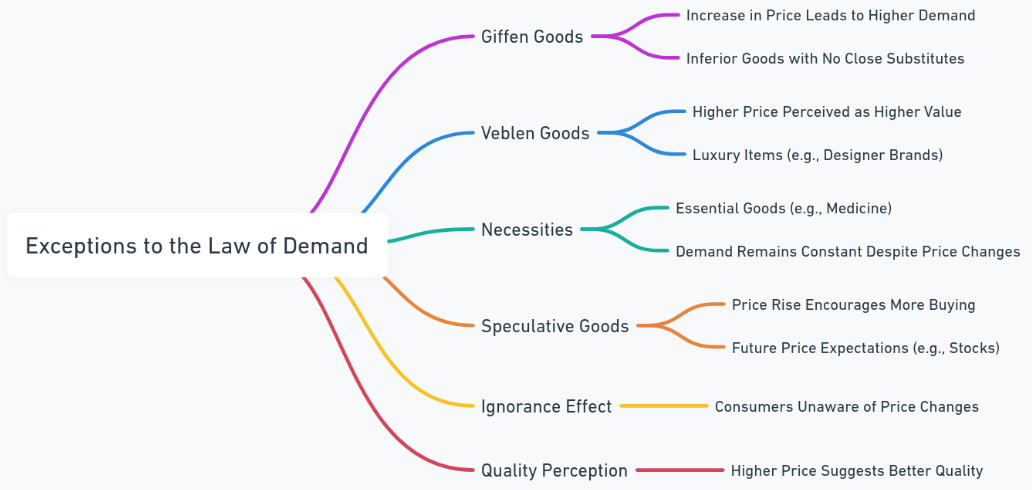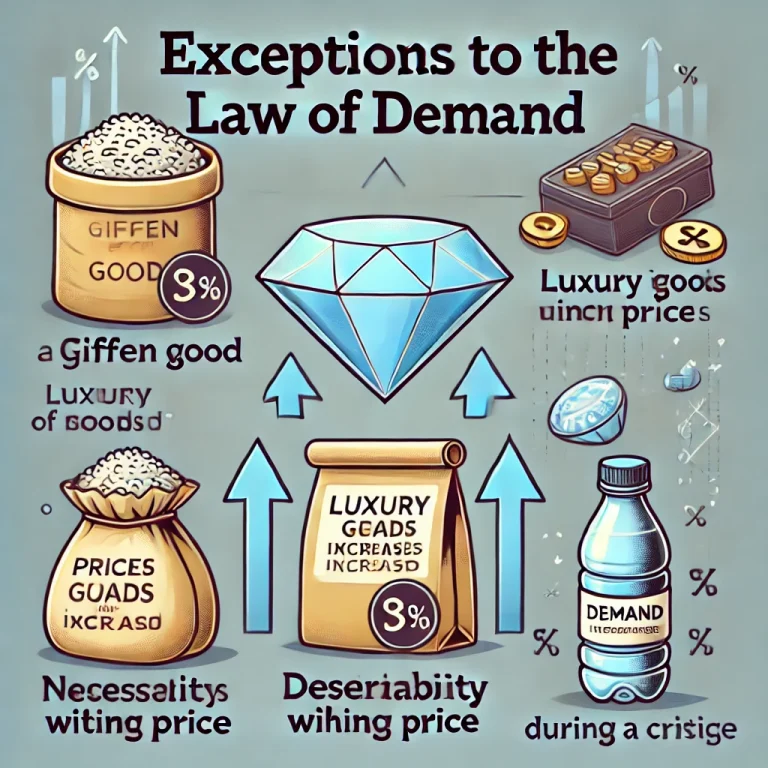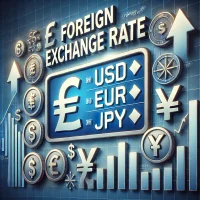The concept of “exceptions to the law of demand” is pivotal in understanding situations where consumer demand defies typical economic principles. The law of demand posits that when the price of a good or service rises, its demand generally decreases, and conversely when the price falls, demand increases. However, there are several notable cases where this relationship does not hold. These exceptions range from unique consumer preferences to broader economic phenomena.
Below, we examine the law of demand, then explore major exceptions like Giffen Goods, Veblen Goods, economic scenarios like the Great Depression, and other behavioral and economic factors that can override standard demand principles.
What is the Law of Demand?
The law of demand is a fundamental economic principle stating that all else being equal, an increase in the price of a good or service leads to a decrease in quantity demanded, while a reduction in price results in an increase in quantity demanded. This inverse relationship between price and demand arises because higher prices typically reduce consumers’ purchasing power, while lower prices make goods more affordable, thus increasing demand.

What are the Exceptions to the Law of Demand?
While the law of demand applies to most goods and services, there are several exceptions where demand patterns deviate from this inverse relationship. Below are the key exceptions.
1. Giffen Goods
Giffen Goods are inferior goods for which demand increases as the price rises, contradicting the law of demand. Named after Sir Robert Giffen, these goods are often necessities for low-income households, where no close substitutes are available.
Example:
Consider staple foods like bread or rice. When these goods’ prices rise, low-income consumers might cut back on more expensive foods and buy more bread or rice to sustain their diets.
2. The Great Depression
During the Great Depression, deflationary pressures and reduced consumer confidence led to lower spending, regardless of lower prices. Consumers postponed purchases, anticipating further price drops or fearing income instability, causing demand to decrease despite falling prices.
Example:
Housing prices and stock prices fell sharply, yet demand remained low, primarily due to economic uncertainty rather than a reflection of lower prices.
3. Veblen Goods
Veblen Goods are luxury items for which demand increases as the price rises due to the social prestige associated with high prices. Named after economist Thorstein Veblen, these goods serve as status symbols, where higher prices make them more desirable.
Example:
High-end brands like Rolex or luxury cars such as Lamborghini are purchased more when prices are higher, as the price itself is a feature of the product’s appeal.
4. Expectation of Future Price Changes
When consumers expect prices to rise in the future, they might buy more of the goods now, even if current prices are higher than usual. This expectation-driven demand disrupts the typical law of demand.
Example:
In inflationary periods, consumers often increase purchases of durable goods to hedge against future price increases, boosting demand regardless of current high prices.
5. Necessities
Necessities like medicine or basic foods exhibit inelastic demand, meaning that price changes have little effect on the quantity demanded. For such goods, consumers continue buying regardless of price fluctuations.
Example:
Essential medications, fuel, and basic utilities maintain demand regardless of price changes due to their indispensable nature.
6. Change in Income Levels
The law of demand assumes stable income levels. However, a sudden increase in consumer income can lead to increased demand for goods even if prices rise. Higher-income consumers are less sensitive to price increases, maintaining demand levels.
Example:
During economic booms, consumers may buy more electronics or vehicles, ignoring price increases because their purchasing power has increased.
7. Luxury Goods
Luxury goods, while related to Veblen Goods, are consumed more as individuals’ income increases rather than due to price changes. These goods often defy the law of demand as consumers prioritize them irrespective of price.
Example:
High-net-worth individuals may continue to buy luxury items such as yachts or custom homes, even as prices rise, driven by lifestyle and prestige.
8. Consumer Negligence
In some cases, consumers may not respond to price changes because they are unaware of them or do not pay attention, especially for goods that are not a major portion of their budget.
Example:
A consumer may continue purchasing a preferred brand of soap even after a price increase simply out of habit or due to a lack of awareness of the price change.
9. Demonstration Effect
The demonstration effect describes a phenomenon where consumers increase demand due to social influence, wanting to emulate the lifestyle of others, often regardless of price.
Example:
A popular gadget that friends or neighbors buy may see higher demand even with a rising price, as social influence encourages others to purchase the same item.
10. Changes in Taste, Preferences, and Fashion
Consumer preferences can change due to factors like culture, season, or trends, affecting demand irrespective of price. Goods associated with current trends may see an increase in demand even with higher prices.
Example:
Fashion items like seasonal clothing or trendy technology products often see spikes in demand due to popularity or limited availability, even if prices increase.
11. Stock Exchange Trading
Stock markets show unique demand behavior driven by speculation rather than the direct utility of goods. Stock demand may increase as prices rise due to investor psychology and the expectation of further price gains.
Example:
In bull markets, investors often purchase more stocks despite rising prices, betting on continued upward trends, thus fueling a cycle of increasing demand and price.
Exceptions to the law of demand illustrate the diverse ways consumer behavior can deviate from traditional economic models. Factors like income changes, consumer preferences, and economic environments contribute to unique demand patterns across goods and services. Understanding these exceptions is vital for businesses, policymakers, and economists to grasp the intricacies of market dynamics fully.
Exceptions to the Law of Demand FAQs
What is a Giffen Good?
A Giffen Good is an inferior good for which demand increases as its price rises due to lack of substitutes and necessity for low-income consumers.
Why does the law of demand not apply to Veblen Goods?
Veblen Goods are luxury items where higher prices make them more desirable as status symbols, thus increasing demand.
How does consumer negligence affect the law of demand?
When consumers are inattentive or unaware of price changes, they may continue purchasing a good even if its price has increased.
Can luxury goods be considered an exception to the law of demand?
Yes, luxury goods often maintain high demand among affluent consumers despite rising prices, driven by income insensitivity.
How does speculation impact demand in the stock market?
In stock trading, rising prices often boost demand as investors speculate on continued price increases, leading to demand driven by market psychology rather than utility.


